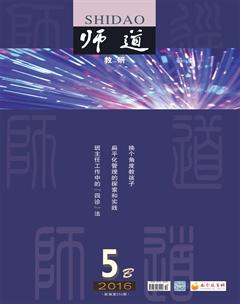优化教学设计,构建高效英语课堂
陈红咏
使用人教版《新目标英语》以来,我在自己上课或听课过程中,发现课堂教学中词汇教学费时多,学生进行语言能力培养的时间相对少了;部分教材的编排不太恰当,有的内容太零碎,缺乏整体性,有的内容编排轻重不一。基于这种现象,我们有必要通过优化教学设计来提高课堂效率。
通过一节课使每个学生个体都有所发展,这样的课堂称之为高效课堂。“高效课堂”主要涉及两个方面的研究:教师与学生,即教与学以及两者之间的相互关系。打造高效课堂不仅仅是让学生能学有所获,教师也能在教学中实现成长找到成就感,形成“学生乐学,教师乐教”的良好局面。
一、优化教学设计
1. 学段教学全面规划。随着教师教龄的变化,在教学中考虑的学段也是不同的,一个优秀的教师可以考虑到三年的学段,而教师在教学中考虑的最小范围是一本书(一个模块),这个模块中涉及到哪些话题,哪些语言知识,需要教师整体考虑。
2. 单元教学要整体安排。每一单元有个话题(topic),整个单元都围绕这个话题开展,教师需要考虑所教内容在整个单元中处于什么位置,对前面已学知识和将要学到的知识有整体安排。然后想到课堂教学优化设计,这样课堂优化设计就有了前面的基础,为后面进一步的学习也奠定了基础。
3. 课堂教学优化设计。课堂教学设计前必须回答的问题:学生将要学什么?学生学完后将能做哪些他们以前不会做或做不好的事?在教学之前就想到最终结果,在教学中不断铺垫,为学生搭建台阶,以达到期待的教学结果。在做教学设计前首先要明确学习哪些内容,学生会做哪些事情,这些事情是否能成功既基于对该内容的学习,也基于教师的铺垫。教师从所期待的结果进行逆推,就使课程非常顺利,输入输出就能一致,为学生提供必要的学习的帮助,那么这节课就能成为一个师生互动的、达成教学目标的课。
二、单元整体教学设计
以《新目标英语》八年级上Unit 1 “Where did you go on vacation?”Section B的教学实践为例,谈谈我在以话题为主线的单元整体教学方面的尝试。
自主设计题目:My trip to Beijing
Step 1 Warming up
(1)Teacher uses the flash cards and gets students to go over the verbs past form. eg:go—went,am(is)— was,are—were.
(2)Teacher says:in Section A,we talked about peoples vacation. We know,some people would like to stay at home, do some washing, watch TV, read books and have a good rest for vacation. However,some people would like to go out to enjoy some interesting places for their vacation. Now,what do you usually do for your vacation? Where would you like to go on vacation?I have some pictures of worlds interesting places. Look at the screen and lets enjoy these interesting places.
(3)Teacher shows PPT about “the statue of liberty”.
T:Which place is it?
Ss:Its the statue of liberty.
T:Where is it?
Ss:Its in New York city in the USA.
(Teacher shows more pictures such as Big Ben,Eiffel tower, Sydney Opera, etc)
(4)Students do pair work
—Where did you go on vacation?
—I went to …
—Did you go to …?
—Yes,I did./ No,I didnt.—How great!/What a pity!
Step 2 Leading-in
T:Lets look at another picture. Which place is it?Where is it?(Ss…).Last May day,I went to Beijing. I knew something about Beijings interesting places, Beijings food, people…Do you want to enjoy my trip to Beijing and know more about Beijing?
Step 3 Presentation
T:Whats this?(Show a picture of Beijing duck)
Ss: It is Beijing duck.
T:How was Beijing duck?
Ss:it was delicious.
Step 4 Practice (pair work)—Hi,Lucy.
—Hi,Mary.
—Hows it going?
—Pretty good.
—Where did you go on vacation?
—I went to Beijing.
—Did you visit the great wall?
…
Step 5 Listening
Play the tape and Ss do listening on P 62,2b,2c.
(1) First try to get the Ss to listen,then answer two questions.(2) Listen again and choose the correct words which you hear:
her vacation:great/ terrible
the people:warm/ friendly/ unfriendly
the food:delicious/ awful
the stores:expensive/ cheap
Step 6 Task Reading
Task1:Teacher shows the PPT(a reading material about traveling),Ss try to read and find the answers to the questions that are given by the teacher.
Task2:Look at your books P 63. There are three diaries about Bob. Now read them quickly then find the following answers to the questions.(Teacher shows questions on the PPT)
T:After reading,can you find what kind of writing way it is?(Ss:….)
T:Well, its a diary.(Talks more about how to write a diary)
Step 7 Writing—My trip to Beijing
T:Now,we have learned more about Beijing. Lets write a diary about my trip to Beijing,open your books and try to finish the writing(Students books 3b).
通过话题教学,学生在情景中使用英语,实现了话题课多维信息的互动,实现了以读促说、以读促写、以写促读。学习兴趣得到了极大的发挥,学习的积极性得到了最大限度的调动。
责任编辑魏文琦

